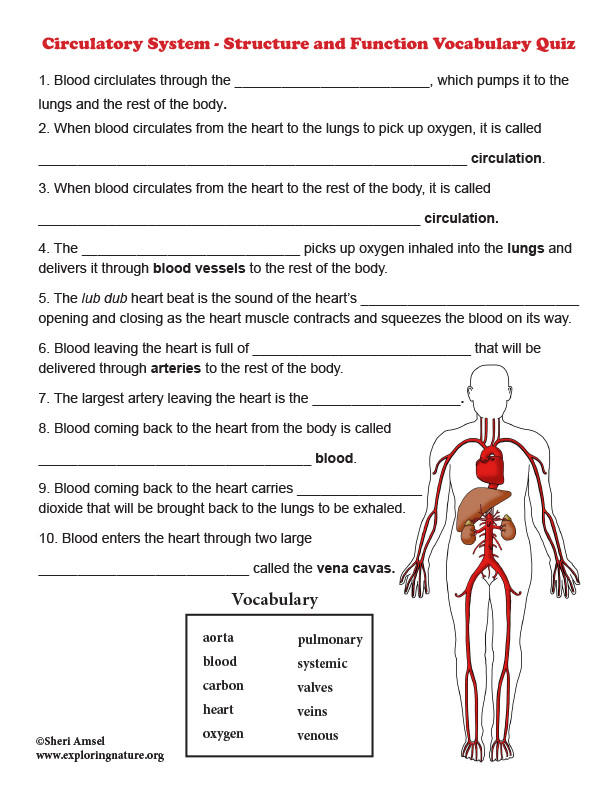Have you ever wondered how oxygen gets to your brain or how your body fights off infection? The answer lies in your circulatory system, a complex network of blood vessels and the heart that work tirelessly to keep you alive. I remember in high school, during a biology class, my teacher had a really cool demonstration using a simple model to explain how blood flows through the heart. It helped me visualize the process, and it’s stuck with me ever since. I’m sure you’ll find these questions and answers about the circulatory system equally enlightening.

Image: mungfali.com
Understanding how your circulatory system functions is essential for maintaining good health. It’s a crucial part of your body’s overall wellness. This article will delve into the fascinating world of blood flow, providing you with clear, concise information to help you grasp this essential bodily function.
Understanding the Circulatory System
Imagine a vast highway system with a central pumping station – that’s essentially what your circulatory system is like. The highway system is represented by your blood vessels, carrying red blood cells loaded with oxygen and nutrients to every cell in your body. The pumping station is your heart, tirelessly working to keep the blood flowing.
The circulatory system, also known as the cardiovascular system, is responsible for transporting oxygen, nutrients, hormones, and other essential substances throughout the body, while simultaneously removing waste products like carbon dioxide. This intricate network consists of:
Components of the Circulatory System
- Heart: This powerful muscle acts as the central pump, pushing blood through the arteries.
- Blood Vessels: These are the pathways for blood flow, including:
- Arteries: Carry oxygenated blood away from the heart.
- Veins: Carry deoxygenated blood back to the heart.
- Capillaries: Tiny blood vessels that connect arteries and veins, facilitating the exchange of oxygen, nutrients, and waste products.
- Blood: The lifeblood, containing red blood cells (carrying oxygen), white blood cells (fighting infections), platelets (helping with clotting), and plasma (the liquid component).
The Journey of Blood Through the Circulatory System
The journey of blood through the circulatory system starts with the heart. The right atrium receives deoxygenated blood from the body. The blood then flows into the right ventricle, where it is pumped to the lungs through the pulmonary artery. In the lungs, carbon dioxide is exchanged for oxygen. The oxygenated blood then returns to the heart through the pulmonary vein, entering the left atrium. From there, it flows into the left ventricle, the strongest chamber, which pumps the oxygenated blood to the rest of the body through the aorta, the largest artery.
This continuous cycle of oxygenation and deoxygenation of blood ensures that every cell in your body receives the oxygen and nutrients it needs to function. The circulatory system is a marvel of nature, constantly working to keep you alive and well.

Image: study.com
Maintaining a Healthy Circulatory System
Keeping your circulatory system healthy is vital for overall wellbeing. Here are some tips:
Tips for a Healthy Circulatory System
- Eat a Heart-Healthy Diet: Focus on fruits, vegetables, whole grains, lean protein, and healthy fats. Limit processed foods, saturated fats, and trans fats.
- Exercise Regularly: Aim for at least 30 minutes of moderate-intensity exercise most days of the week. Regular physical activity strengthens your heart muscle and improves blood flow.
- Maintain a Healthy Weight: Being overweight or obese puts extra strain on your circulatory system. Focus on healthy eating and exercise to reach a healthy weight.
- Manage Stress: Chronic stress can increase your risk of heart disease. Find healthy ways to manage stress like yoga, meditation, or spending time in nature.
- Quit Smoking: Smoking damages your blood vessels and increases your risk of heart disease, stroke, and other circulatory problems.
- Get Regular Checkups: Regular checkups allow your doctor to monitor your blood pressure, cholesterol levels, and overall cardiovascular health.
Common Questions and Answers About the Circulatory System
Q: What is blood pressure and why is it important?
A: Blood pressure is the force of blood pushing against the walls of your arteries. It’s measured in millimeters of mercury (mmHg) and typically expressed as two numbers, for example, 120/80 mmHg. The top number (systolic pressure) represents the pressure when your heart beats, while the bottom number (diastolic pressure) represents the pressure when your heart rests between beats. High blood pressure is a major risk factor for heart disease, stroke, and other circulatory problems.
Q: What is cholesterol and how does it affect the circulatory system?
A: Cholesterol is a waxy substance found in all cell membranes. There are two main types: low-density lipoprotein (LDL) cholesterol, often called “bad” cholesterol, and high-density lipoprotein (HDL) cholesterol, often called “good” cholesterol. High LDL cholesterol levels can build up in the arteries, leading to atherosclerosis, a hardening of the arteries that can restrict blood flow and increase the risk of heart disease. HDL cholesterol helps remove LDL cholesterol from the bloodstream, reducing the risk of heart disease.
Q: What are the signs and symptoms of circulatory problems?
A: The symptoms of circulatory problems can vary depending on the underlying cause. However, common signs include:
- Chest pain or discomfort (angina)
- Shortness of breath
- Fatigue
- Swelling in the legs or feet
- Numbness or tingling in the hands or feet
- Changes in skin color (e.g., pale, blueish, or reddish)
- Dizziness or lightheadedness
Circulatory System Questions And Answers Pdf
Conclusion
Understanding how your circulatory system works is crucial for maintaining good health. By following the tips outlined above, you can help protect your heart and increase your chances of living a long and healthy life. Are you interested in learning more about the circulatory system? Would you like to explore specific circulatory conditions in greater detail?






